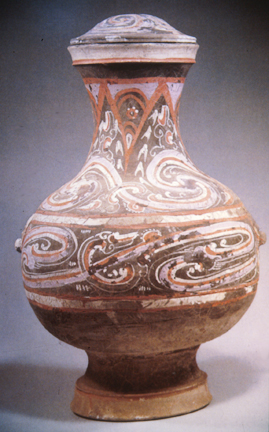
HAN DYNASTY LIDDED VASE (HU),
China, Honan Provice, 100 BCE, 22" height
ART 198 - HISTORY OF WORLD CERAMICS
| The HAN DYNASTY (206 BCE - 220 CE) was a period of relative peace and flourishing trade. This lidded vase (hu) was thrown on a sophisticated, fast wheel of a gray earthenware and vigorously painted in swirling designs of polychrome slip. Its shape is clearly derived from Shang bronze prototypes. While bronze vessels were reserved for royalty, wealthy patrons commissioned ceramic copies for their burials. During the Han Dynasty, the silk trade route was opened via Turkestan to the Eastern Roman Empire, and by sea to India and Persia. This 'silk road' stretched for over 5,000 miles from the Han capital at Luóyang on the Yellow River to Rome. The Chinese traded lacquer, silks, and ceramics in exchange for gold and silver. In addition to using the fast wheel, Han potters mastered the use of complex molds, a technology adapted from the casting of bronzes to allow them to create a large vocabulary of ceramic shapes. | HAN DYNASTY LIDDED VASE (HU), China, Honan Provice, 100 BCE, 22" height |
|
|